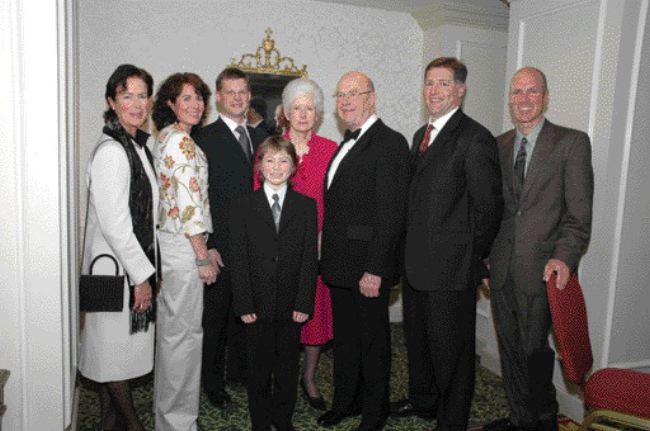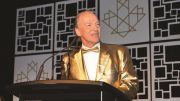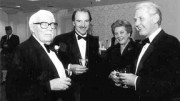The Canadian mining industry has come a long way since Samuel de Champlain spotted copper minerals during his exploration of the Gasp area in the early 1600s.
Three hundred years later, the late Alfred E. Miller (1880-1983) noticed copper-stained rocks on the bed of the York River, in the Gasp Peninsula.
That discovery eventually led to the construction of the Gasp Copper Mines complex by Noranda Mines in the 1950s, which produced more than 150 million tons averaging 1% copper over the next 50 years.
Miller, along with three other noteworthy men, were inducted into the Canadian Mining Hall of Fame at the recent annual awards ceremony at Toronto’s Fairmont Royal York Hotel.
A crowd of 700 gathered to recognize Miller, George B. Cross, R.G.K. Morrison and Harry L. Roscoe for their contributions towards mining in Canada.
Three other members of the Hall of Fame were also present: William Guy Brissenden, William James, and Michael J. Knuckey.
Hotel and other arrangements were made by a special committee from the Women’s Association of the Mining Industry of Canada (WAMIC). The committee also liaises between the inductees and the Hall of Fame. In return, the Hall of Fame makes a donation to the WAMIC Foundation, which provides scholarships and bursaries to students studying earth sciences and other mining fields.
After a year that saw the loss of mainstays such as Falconbridge, Inco and Placer Dome, master of ceremonies Pierre Lassonde noted that while it’s sad to see these companies go, the industry has the ability to renew itself.
Lassonde, the vice-chair of Newmont Mining (NMC-T, NEM-N) and the company’s former president, listed major international companies operating in Canada — Barrick Gold (ABX-T, ABX-N), Goldcorp (G-T, GG-N), Alcan (AL-T, AL-N), Newmont Mining and Teck Cominco (TCK.B-T, TCK-N) — which have grown substantially in the past few years to a combined market cap of over $100 billion.
George Cross spent his life informing investors about mining companies as the principal writer and researcher for the George Cross News Letter, which was started by his father, George Carmichael Cross in 1947.
From the time he joined the newsletter in 1952, until its demise in late 2000, Cross provided breaking news and updates on new discoveries to readers in 35 countries often before the mainstream media had any knowledge of them.
He travelled around the world to hundreds of mineral projects separating fact from fiction, and reassuring investors that their venture capital was in the right place.
“Using the pen as the proverbial sword, he cut through the hype and the B.S. and embellished some press releases before National Instrument 43-101,” said Lassonde.
Cross jokingly thanked the selection committee for choosing him as the living inductee to the Hall of Fame this year. But looking back on his 50-year career proved emotional as he thanked his family, colleagues and subscribers through a slightly quavering voice. Cross also spoke of his 10-year-old grandson, Matthew, who has shown an interest in geology, but not mining awards ceremonies.
“He didn’t want to come to dinner,” explained Cross. “He asked me, ‘Am I going to be bored, Grandpa?'”
R.J.K. Morrison, (1899-1983) the father of rock mechanics, was anything but bored during his career. After narrowly escaping a rock burst in a mine in India that killed two of his colleagues, Morrison dedicated his life to preventing such accidents. Morrison became the authority on the sudden failures of highly stressed rock around mine openings. He introduced the concepts of doming — the development of the stressed zones around mine openings, and sequential mining — the orderly planned excavation of the stopes in a sequence. These new practices made mining safer and more predictable, after having claimed 20 to 50 lives per year in Ontario during the 1930s and ’40s.
John Carrington, retired COO and vice-chair of Barrick Gold, was a former geology student of Morrison’s at McGill University in Montreal. Carrington said Morrison sent him a copy of his “bestseller,” Philosphy on Ground Control, in 1970.
“On the inside cover, he wrote, ‘This might be helpful in the case of insomnia,'” Carrington said.
But humour aside, Morrison added, “Mining is an industry where good judgment, often most conspicuous in hindsight, carries a bigger premium than most other industries. The fundamentals of good judgment are knowledge and experience.”
And Morrison’s life was all about the mining experience, said his son Bob.
“The only holiday I ever took with my father was a trip to the Gasp, though we somehow managed to get in a fairly extensive visit at a copper mine,” he said.
Harry Roscoe (1885-1963), who joined Noranda Mines in 1926 and retired as vice-president, director and top technical person in 1959, was most known for his development work at the Horne copper mine in Sudbury. The mine grew from producing 1,000 tons per day to 4,000. Under his leadership, new mining methods were developed, such as the use of a cemented backfill in mined-out stopes to increase recoveries, and the use of a 2,200-ft. conveyor belt to hoist underground primary and secondary crushing to the surface.
Roscoe’s son Claude reminisced about a trip he took with his father to the O’Brien gold mine in Quebec to examine a rich vein.
“We were promptly taken underground, went into a narrow drift through a lockable gate,” Roscoe said.
Why is it locked, he wondered.
The younger Roscoe was shown an overhead gold quartz vein and learned a trick of the trade back in the day.
“When the mill was short of ore grade, they would send the crew down with a powder box and bring it up and dump it in the mill to raise the grade,” Roscoe said.






Be the first to comment on "Four join Mining Hall of Fame"